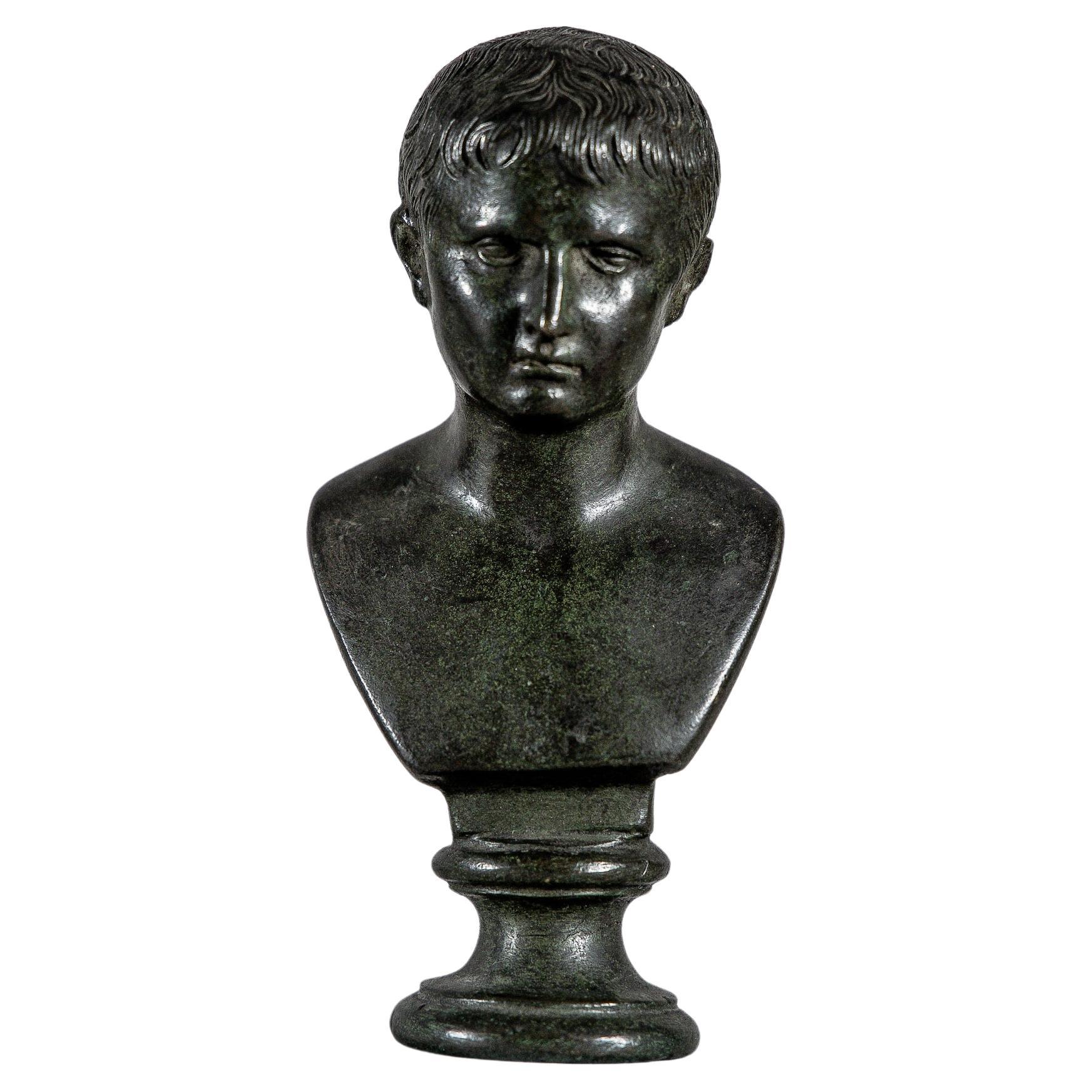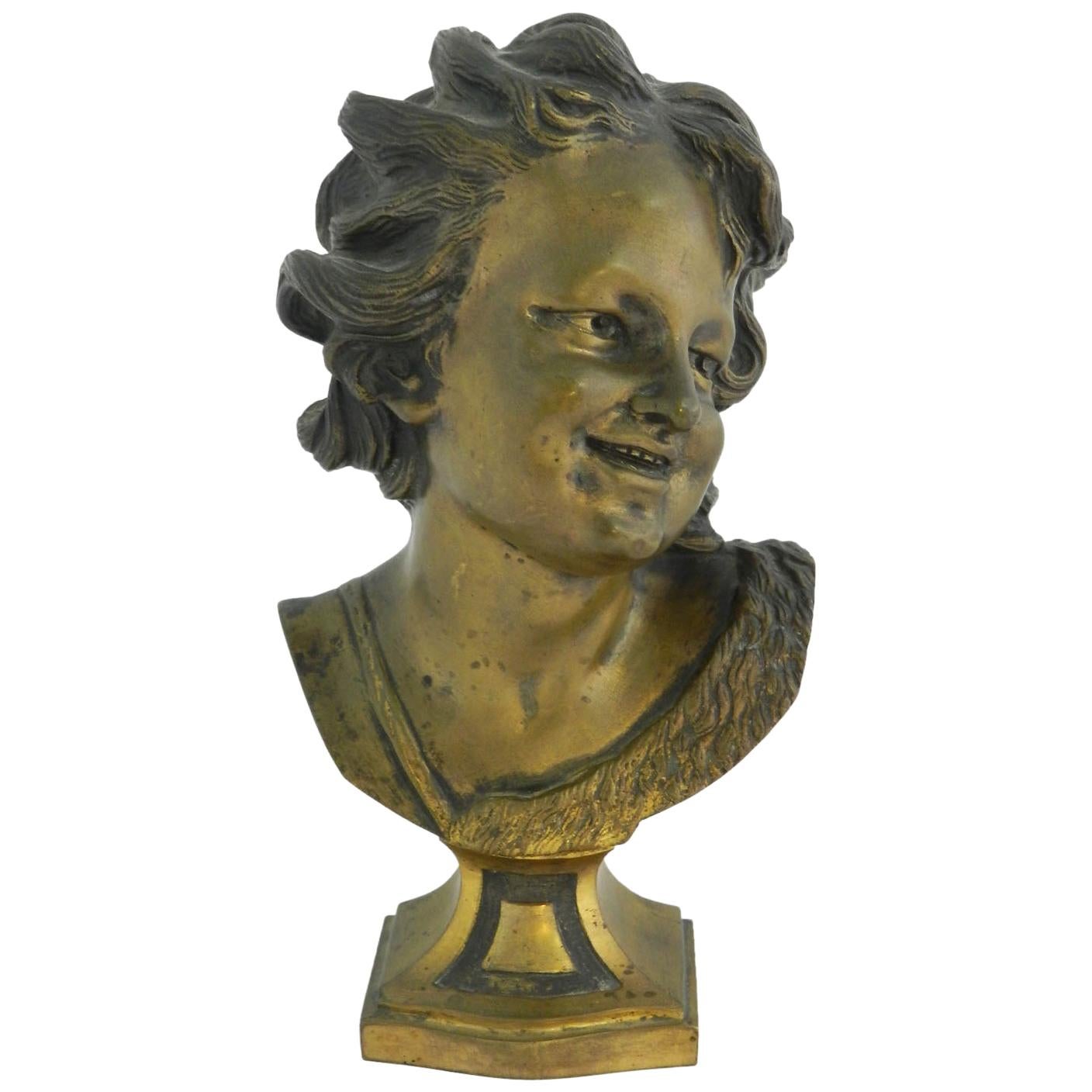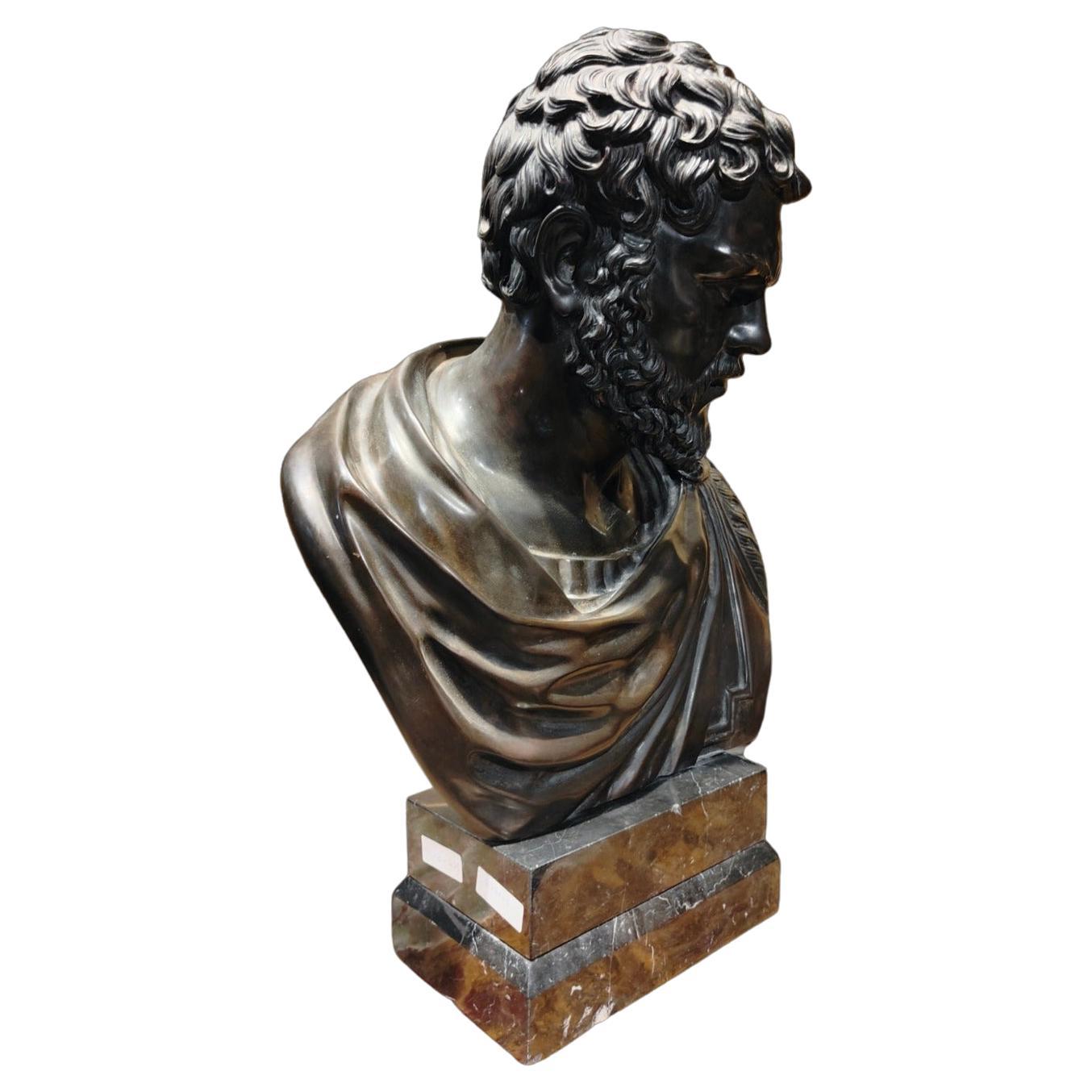Items Similar to Large 19th Century Bronze Bust
Video Loading
Want more images or videos?
Request additional images or videos from the seller
1 of 22
Large 19th Century Bronze Bust
About the Item
A superb 'Grand Tour' bronze bust, traditionally described as Dionysus (Dionysos), after the original excavated at the Villa of the Papyri in 1754; by the Sabatino and Sons foundry, Naples.
Mounted on a faux-porphyry base. Italy, 1890–1900 (The pedestal is available in a separate listing).
Superb quality, original patination. A similar bust, though of a later date and inferior quality, was sold Christie's London, 19 July 2022, lot 73 (£15,120)
Why we like it
Exquisitely sculpted, with beautiful patination, this handsome head has most attractive features and it reflects the Ancient Greek ideal of beauty. We were captivated by its timeless beauty while on a trip to the National Archaeological Museum in Naples (last image) and later, on Capri island in 2020, where an identical bust could be seen at the whimsical Villa San Michele, the life’s work of the Swedish Royal physician, author and collector Axel Munthe (1857–1949). Coveted by the 19th century intellectuals and aesthetes, such exquisite objects were not mere decorations, but symbols of their owner's classical values and refined taste. Further examples graced the rooms of such style and fashion luminaries as Yves Saint Laurent, Pier Luiggi Pizzi and Karl Lagerfeld. Please, see the last five images in the listing.
History
The bust dating from the mid-1st century AD, found in 1754 in the peristile of the so-called Villa of the Papyri at Herculaneum had long been misidentified as Plato, but was in fact, an upper part of a herm, most likely of Dionysus, and is now preserved at the Naples Archeological Museum.
Johann Joachim Winckelmann (1717-1768), a German art historian and one of the founders of scientific archaeology, wrote about this bust in his Critical account of the situation and destruction by the first eruptions of Mt. Vesuvius, of Herculaneum, Pompeii and Stabia in 1762: 'The buckles formed by the hair of the head which has a long beard, are foldered only on the sides. The workmanship of this head is likewise worth our notice, as infinitely superior to that of all our modern artists. It is one of the most perfect pieces in the whole world; and I may take upon me to say that it is impossible for the art of man to produce any thing, in any branch superior to it...'
Villa of the Papyri was an ancient Roman villa in Herculaneum, in what is now Ercolano, southern Italy. It is named after its unique library of papyri (or scrolls), discovered in 1750. The Villa was considered to be one of the most luxurious houses in all of Herculaneum and in the Roman world. Its luxury is shown by its exquisite architecture and by the very large number of outstanding works of art discovered, including frescoes, bronzes and marble sculpture which constitute the largest collection of Greek and Roman sculptures ever discovered in a single context. It was situated on the ancient coastline below the volcano Vesuvius with nothing to obstruct the view of the sea. It was perhaps owned by Julius Caesar's father-in-law, Lucius Calpurnius Piso Caesoninus. In AD 79, the eruption of Vesuvius covered all of Herculaneum with up to 30 metres (98 ft) of volcanic material from pyroclastic flows. Herculaneum was first excavated in the years between 1750 and 1765 by Karl Weber by means of tunnels. Most of the villa is still underground, but parts have been cleared of volcanic deposits. Many of the finds are displayed in the Naples National Archaeological Museum.
The De Angelis Foundry (Naples, 1840–1915)
Chiurazzi, De Angelis and Sommer where the main Neapolitan foundries that catered for the needs and tastes of the grand-tourists throughout the 19th and early 20th centuries. The Fonderia de Angelis, active from 1840, was instead the oldest of the three and certainly the most prestigious. Edwan Robinson, the director of the Boston Museum of Fine Arts since 1902, wrote about its founder, Sabatino de Angelis (b.1838), being 'by far the best of the Neapolitan copyists, his talent and feeling for his line of work being rare in any generation'.
- Creator:Sabatino De Angelis (Maker)
- Dimensions:Height: 23.63 in (60 cm)Width: 17.72 in (45 cm)Depth: 11.82 in (30 cm)
- Style:Grand Tour (In the Style Of)
- Materials and Techniques:Bronze,Patinated
- Place of Origin:
- Period:
- Date of Manufacture:circa 1890
- Condition:Wear consistent with age and use. Superb original patination; early 20th century faux porphyry stand.
- Seller Location:London, GB
- Reference Number:1stDibs: LU1781228390312
About the Seller
5.0
Platinum Seller
These expertly vetted sellers are 1stDibs' most experienced sellers and are rated highest by our customers.
Established in 2014
1stDibs seller since 2016
211 sales on 1stDibs
Typical response time: <1 hour
Associations
LAPADA - The Association of Arts & Antiques Dealers
- ShippingRetrieving quote...Ships From: Richmond, United Kingdom
- Return PolicyA return for this item may be initiated within 7 days of delivery.
More From This SellerView All
- Antique Bronze Etruscan Candelabrum 19th CenturyBy F. Barbedienne FoundryLocated in London, GBAn exquisitely cast and patinated bronze 'Etruscan' candelabrum in the Grand Tour taste. France or Italy, mid- to late 19th century. Why we like it We love the finest quality of cas...Category
Antique 19th Century French Grand Tour Candelabras
MaterialsBronze
- Pair of 19th Century Ormolu and Patinated Bronze CandelabraLocated in London, GBA fine pair of Regency period gilded and patinated bronze candelabra or candlesticks. English, circa 1810. Why we like them Exquisite, late neoclassical design; beautiful co...Category
Antique Early 19th Century English Regency Candelabras
MaterialsOrmolu
- 19th Century Leather Slipper ChairLocated in London, GBA charming Georgian style slipper chair of compact proportions, covered in well-aged, possibly original buttoned leather. England, circa 1860. Why we like it Very comfortable and w...Category
Antique Mid-19th Century English Victorian Slipper Chairs
MaterialsLeather
- Antique 19th Century Regency Table LampBy Thomas HopeLocated in London, GBA very decorative Grand Tour vase after a design by Thomas Hope, mounted as table lamp, in porcelain with matte turquoise ground and glazed classical ornaments. English, early 19th c...Category
Antique Mid-19th Century English Regency Table Lamps
MaterialsPorcelain
- Antique Slipper Chair Early 19th CenturyLocated in London, GBAn interesting early 19th century slipper chair of small proportions, retaining original needlework upholstery, English, circa 1835. The chair p...Category
Antique Early 19th Century British Early Victorian Slipper Chairs
MaterialsUpholstery, Hardwood
- Antique Beadwork Tapestry Picture, Early 19th CenturyLocated in London, GBAn exquisite early 19th century gros-point and beadwork tapestry picture, in antique parquetry frame. Size of the panel: 20.75 in / 52.5 cm by 21.25 in / 54 cm.Category
Antique Early 19th Century English George II Tapestries
MaterialsTextile, Wood
You May Also Like
- 19th Century Bronze Bust of Caesar on Marble PedestalLocated in Kilmarnock, VANicely detailed Bronze bust of Caesar with terrific age acquired patina made in Italy during the late 19th century during the Grand Tour.Category
Antique Late 19th Century Italian Grand Tour Busts
MaterialsMarble, Bronze
- Small Bronze Bust of the Boy Octavian, 19th CenturyLocated in Greding, DESmall bronze bust of young Octavian, later Emperor Augustus and first Roman Emperor.Category
Antique 19th Century Italian Grand Tour Busts
MaterialsBronze
- Late 19th Century Bronze Bust SculptureLocated in Dallas, TXVictor Leopold Bruyneel is a Belgian sculptor who was born in 1859. Girl with a Floppy Hat Bronze Figure for Tiffany & Co.Category
Antique Late 19th Century French Busts
MaterialsBronze
- 19th Century French Bronze Bust StatueLocated in Labrit, LandesAntique French bronze bust 19th century Decorative and heavy classical French figure head Good condition with good patina due to age.Category
Antique Late 19th Century French Neoclassical Revival Busts
MaterialsBronze
- 19th Century Bronze Bust of HomerLocated in Dublin 8, IE19th Century bronze bust of Homer attributed to the attributed to the Chiurazzi Foundry, Naples, Italy. Homer was author of the epic poems the Iliad and the ...Category
Antique 19th Century European Neoclassical Busts
MaterialsBronze
- Large Roman Bronze Emperor Bust from the 19th CenturyBy Europa AntiquesLocated in Madrid, ESLARGE Roman bronze from the 19th century. Important bronze from the end of the 19th century roman signed S.V. The black marble base is later. Grand tour of Rome. Excellent condition ...Category
Antique 19th Century Italian Baroque Figurative Sculptures
MaterialsBronze
Recently Viewed
View AllMore Ways To Browse
The Modern Find
Rare Bust
Bust Of A Head
Museum Bust
Antique Objects List
Dionysus Dionysus
Grand Tour Bronze
Grand Touring Bronzes
Antique Grand Tour Bronze
The Grand Tour Sculpture
Grand Tour Original
Bust Sold
Grand Villa
Italian Grand Tour Sculpture
Grand Tour Bronze Sculpture
Large Grand Tour
Italian Grand Tour Bronzes
Grand Tour Marble Sculpture





